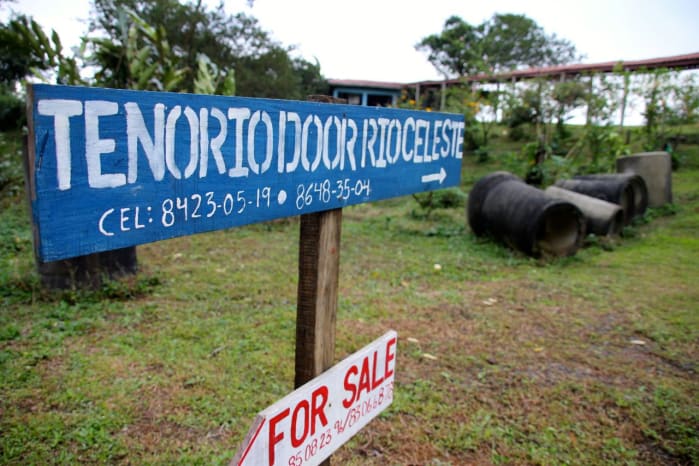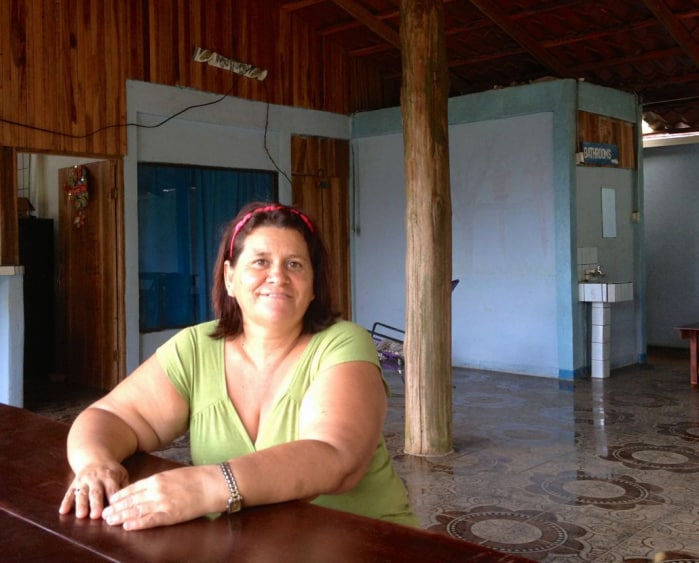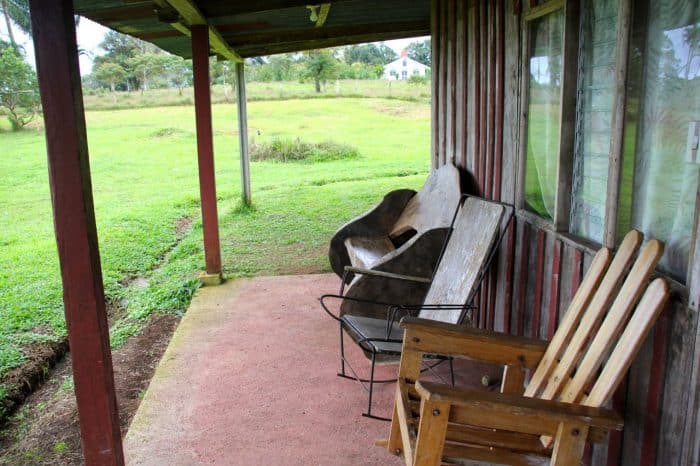It is The Tico Times’ policy to conduct reviews anonymously. If we have reviewed your establishment and you disagree with our assessment, you are welcome to comment on the article, and if you wish, request a follow-up review.
*
To reach Tenorio’s Door, I took an unmarked taxi up a rubble-strewn road in the middle of the night. The Jeep Tracker bounced and creaked, and stones raked the chassis. Horses huddled by the side of the road, neither fenced nor feral, and every few feet we startled some birds, which flapped by the headlights. The taxista was among only a few in town, and he had never heard of Tenorio’s Door. But he understood the directions: Drive from Bijagua toward Río Celeste, and just before you get there, stop.
With its Tolkienian name and obscure locale, Tenorio’s Door blends fluently into the rural landscape. The building is small and simple, set atop a dewy meadow. The four rooms are strictly functional – rough wooden walls, bunk beds, mosquito nets and a lukewarm shower. After smashing a cockroach into the floorboards, I was sure to shake out the blankets. Not surprisingly, I only knew of the place because a fellow backpacker recommended it.

But Tenorio’s Door is aptly named, because it’s located as close to Tenorio National Park as a hostel can be. I awoke to the crow of a rooster and stumbled my way to Soda Doña Ana, where a plate of gallo pinto, fried eggs and salted cheese awaited me. On that overcast morning, the robust green hills looked look a Scottish heath; now and again, cows would moo across the fences. The pitcher of mixed-fruit refresca natural was the perfect companion to black coffee.
“I don’t like San José,” said Doña Ana, who owns Tenorio’s Door and the restaurant and cooked all the food herself. “It’s much better here. More peaceful.”

Hordes of tourists visit Río Celeste every year to witness its magical turquoise waters. Many of them lodge in Bijagua, the nearest town, and well-heeled travelers stay at the lavish Río Celeste Hideaway. Independent tourists are wise to rent a car, since the region is frustrating to reach by bus, and cabs can be brutally expensive. If you have money to spend, Río Celeste can be a very comfortable experience.
But Tenorio’s Door is a boon for hearty backpackers, the kinds of folks who carry Nalgene bottles and can communicate in Spanish. Far from the bustling metropolis of Bijagua (pop. 2,000), the hostel has no late-night bar, no television set, and no Wi-Fi. I found this Spartan tranquility so relieving; at dinner, I watched a katydid – which looked exactly like a green leaf – strut its way across the concrete floor. My Eastern European neighbors played cards by flashlight at a wooden table, until they retired to their tent, which they had set up in the grass. When everyone else was asleep, I took a stroll down the dark road, where I ran into a leathery campesino and chatted about the weather. Later, as I read a book in my bunk, a rainstorm suddenly pummeled the roof, and its drumming eased me into sleep.
All across the country, there are hostels that advertise “cabinas,” but at Tenorio’s Door, the cabinas actually feel like cabins. Instead of “rustic charm,” Tenorio’s Door is actually rustic. You are encouraged to wash your laundry in the sink and hang it on a line; you can play soccer in the overgrown yard, shooting at two weathered goals. Although the place’s website is in English, Doña Ana speaks only Spanish, and you only can pay her in cash. If you sit around long enough, Doña Ana will hand you a plate of sliced bananas and talk with you about anything you like. Such places are endangered in the rapidly evolving landscape of Costa Rican tourism. There is no pool. There is no air-conditioning. But all the home-cooked meals are included.

Around 8 a.m., I walked down the ruddy road to the trailhead, a promenade that took only a few minutes. The path was mucky and crisscrossed with debris; the rain forest was thick with fog. But these qualities made me enjoy the hike all the more. The woods boasted a druidic atmosphere that I would never experience on a sunnier day. When I reached the edge of Río Celeste, the blue waters seemed especially mystical. The place was empty of human life. Only when I returned from the waterfall and Blue Lake did I pass tour groups, who nodded and huffed and disappeared into the fog.
“It’s hard,” said Doña Ana, as I waited for the return taxi. “Tourists pass me all the time. They go into the park, and then they come back, and they don’t stay.”
It takes a certain kind of traveler to love Tenorio’s Door. But for Doña Ana’s sake, I hope there are more of them.
Going There:
To get to Bijagua from San José or Liberia, take Highway 1 to Cañas, then turn onto Route 6 for Upala. In the middle of Bijagua, take the gravel road toward the entrance of Tenorio National Park. The road is rough, so expect to take between 30 and 45 minutes. A half-mile before the park, you’ll spot the sign for Tenorio’s Door on your left. Accommodations are ₡13,000 ($26) per person per night. For more info, visit Tenorio’s Door website.






